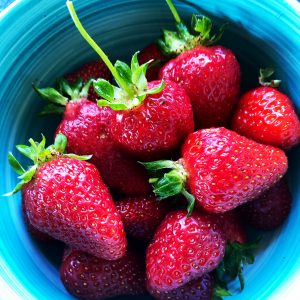Grow Me Now
September
Sold on Strawberries!
Strawberries are a longed-for summer treat, but they so often disappoint. From failing to fully pollinate, lacking flavour, becoming marked by birds, slugs, and snails, rotting before they’re ripe, and simply not returning a decent number of berries, strawberry hassles mean many gardeners give up growing this delicious fruit. If this sounds like you, there is another way to get the crop you crave – and it’s by growing your strawberries in a tunnelhouse. What’s more, strawberries in the tunnelhouse ripen so much earlier than those outside, that you’ll have the ground free for tomatoes and other heat-lovers by the time you need it. As a bonus, tunnelhouse strawberry plants are likely to produce more fruit than those grown outdoors, so you don’t need the same number of plants. And your berries will be super-sweet because of ripening in the warmest of conditions.


Source
Strawberries fruit from spring through until autumn, depending on variety, with ‘Monetrey’ being one of the latest varieties. If you have space in your tunnelhouse to grow strawberries throughout the warmer months, choose a range of varieties. If you need the space for heat-lovers in late spring, choose an early maturing strawberry such as ‘Pajaro.’ If you are already growing strawberries in your outdoor garden, and the variety suits your purposes, dig up a few young plants that have formed on ‘runners’ last season, and use them in your tunnelhouse.
When purchasing plants from the garden centre, inspect them carefully (on the underside of leaves as well) for signs of aphids and other sap-suckers. Once these pests reach the warmth of your tunnelhouse, they will romp away if not checked.


Groundwork
Whether you intend growing your undercover strawberries in the tunnelhouse bed, or in containers, preparation is the same. The soil needs to be rich, loose, and free draining. Dig in lashings of compost made with ingredients that include sterile animal manure and decayed kelp, and add a sprinkling of bone dust. Strawberries are acid-loving, so skip the lime. If you are using inorganic fertilizer, choose one specifically for strawberries, or which has a balanced NPK ratio. Dig all ingredients in deeply, and water the beds or containers well. Leave planting until the next day, once the growing medium has soaked up the moisture and had time to drain.
Transplanting
Strawberry plants can be grown a little closer together in the tunnelhouse than you would outdoors because there is less leaching of nutrients, undercover. Drainage is also more controlled so there is no need to raise the plants up on mounds. Simply make shallow depressions in the bed (or your containers) about 1.5 hand widths apart. Press the plants firmly into the soil, and bring the soil around them without covering their central crown (the point in the centre of the plant from which the leaves grow). The crown should always be above soil level. Lay a light mulch of straw or untreated wood shavings around the plants.


Maintenance
Water the plants before the soil dries out completely, and give them a liquid feed every 7-10 days until fruit begins to set. Check carefully at night, with a torch, for slugs or snails, and remove any you find. Once fruit begins to ripen, keep it free of fungal disease by ventilating the tunnelhouse day and night. Cover doors and vents with netting to exclude birds, or use a specially fitted Tunnelhouse screen door. Snip off (never pull) runners as they appear (‘runners’ are new, young plants which form on a long stem which branches off from the main plant). This will help keep your plants fruiting. Harvest the berries with scissors.
At the end of the fruiting period (when the plants are no longer producing flowers), remove containers of plants outside and into a sunny position. If you have grown your strawberry plants directly into the greenhouse bed, dig them up, and replant them in a spare space in the outdoor garden.
Tip
If using pea straw mulch, take great care to get it from an organic source or to make certain it has not been tainted with Glyphosate. Even a trace of the chemical will damage or kill plants.
If signs of fungal disease appear, move mulch away from the plants to allow for greater air flow. Remove any diseased fruit immediately.
Towards the end of fruiting, allow a handful of runners to develop. Press them into containers of potting mix while they are still attached to the parent plant. Once they are rooted, snip off the runner. These young plants will provide you with next year’s greenhouse crop.
